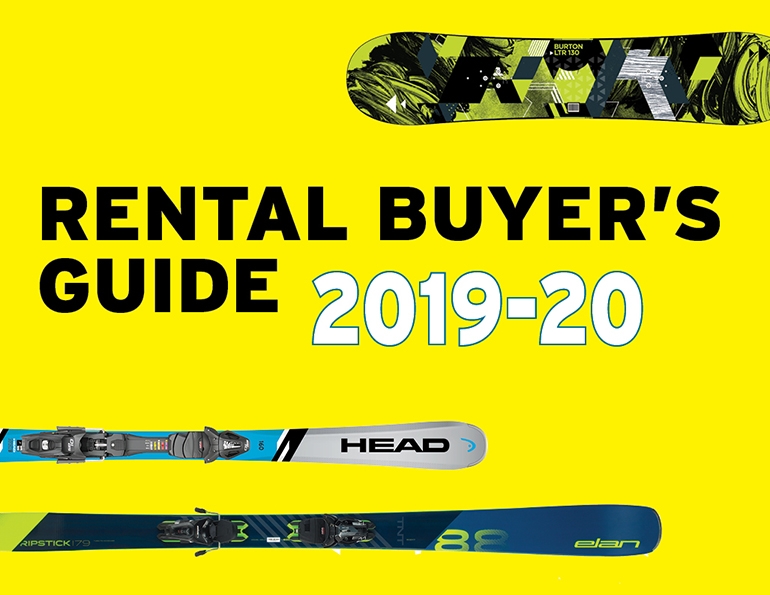The rental shop serves a very broad audience, from newcomers whose first experience could determine whether they become lifelong converts to core customers who are looking for demos or specialty gear for the day. Here’s a look at what alpine and snowboard suppliers have in store.
ALPINE RENTAL 2019-20
Alpine rental buyers will find a lot of familiar product in suppliers' lines this year, which probably comes as good news. Continuity has its advantages. But there is a major change coming, say some suppliers. Forewarned is forearmed.
Rental gear often benefits from technology passed down from in-line gear. This year's top example: GripWalk soles, an adaptation from alpine touring technology. The benefits for rental customers are obvious: GripWalk soles not only provide the eponymous grip on slippery surfaces, they are also slightly arced, allowing for a roll in striding forward to lessen the awkwardness of walking in boots. This makes them the way of the future in rental, according to several manufacturers’ reps.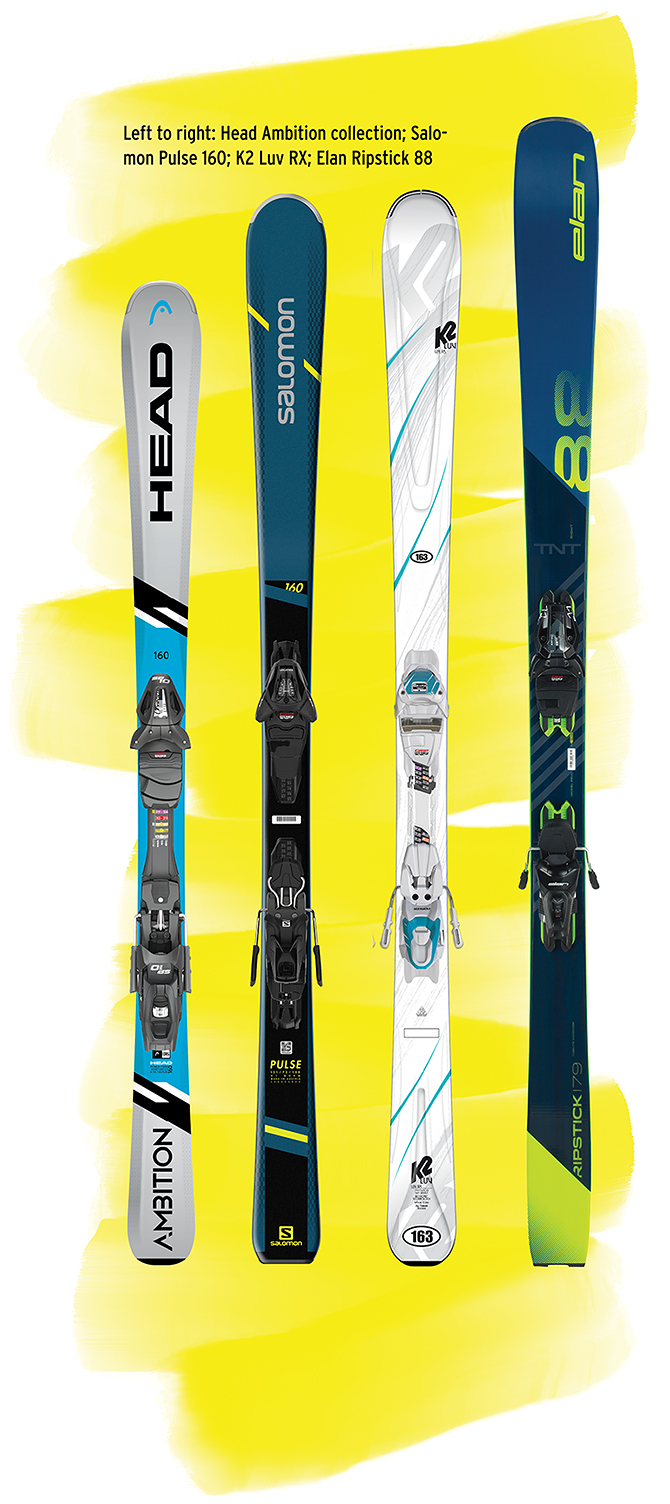
BABY STEPS FOR GRIPWALK
But it's a move that suppliers are, well, slow walking. A two-step process appears to be in play, starting first with GripWalk-compatible bindings (with a GripWalk-compatible AFD). The next step will be a bigger leap to full fleets of rental boots equipped with GripWalk soles. But first, “We need to flush the pipeline of old bindings,” says Rossignol alpine product manager Matt Rhim.
Chris McKearin, Salomon country commercial manager, puts it another way: “We are future-proofing the binding offer, knowing that the boots are coming.”
The bindings-first direction is being pursued by companies like Marker-Dalbello-Volkl (a principal GripWalk proponent), Elan, Salomon, and Rossignol. Still, Rossignol and Salomon are offering after-market GripWalk soles to allow rental customers to retrofit existing boots.
Until GripWalk takes hold, here's what's in store for the rental market.
BABY STEPS OVERALL
Companies are taking a similar slow-walk approach to the overall 2019-20 rental market. Save for a few minor and cosmetic changes, most companies in most cases are going with tried and true technology for 2019-20.
Beyond GripWalk, a few innovations from the past remain in the mix, including:
• The limited-sole-length 4Factor system, pioneered by Dalbello, remains available from Dalbello and Alpina.
• Companies like Elan continue to produce skis specifically for terrain-based learning.
• Head continues its reinvention of the old graduated length method with its Headway program.
STEP-UP MODELS VS. FLEET MODELS
In keeping with the past couple of years, the main focus of most companies is on “step-up” products—skis and boots a step above inexpensive fleet rental gear in both price and performance. Some resorts are on board the concept.
“The market has bought into the step-up trend. People are willing to consider it,” says Head rental manager Mike Poole. However, K2’s Adam Ruscitto says that getting many clients to make the move to a pricier, higher-performing product remains a challenge. Destination resorts are more likely to invest in the step-up models, while Midwest resorts are more likely to make a price-conscious choice, he notes.
Cost-conscious buyers might find that a move up to pricier gear can actually be a money-saver, as the increased durability typically found in more expensive products is likely to extend the turnover cycle by a year or more. In addition, step-up gear can deliver a better early learning experience and produce a higher conversion rate. “There is definitely a tie [between quality equipment and skier conversion],” says Poole, voicing a consensus opinion among rental suppliers.
With that in mind ...
STEPPING UP TO QUALITY
• Elan still offers the entry-level Explore X, but the company is really pushing the step-up and slightly more expensive Element, introduced last year, which has an innovative flex pattern.
• Nordica is pushing a new series of lighter, narrower boots, “inspired by the (in-line) Speed line,” according to director of marketing and communications Sam Beck. The new boots are positioned above Nordica’s wide, 104-mm-last Cruise model that Beck concedes had become “way outdated.”
• Rossignol considers its three-model Experience series as its rental “workhorse,” as Rhim puts it, and offers the 74-mm-waist React and Nova models mainly for “the mid-Atlantic and Midwest markets.”
• Head is introducing two new models that “consolidate everything we know about rental skis,” says Poole. The 78-mm-waist Ambition Pro and the 75-mm-waist Ambition, at a more modest price, offer, among other new features, a new base material (Nibylen) that Poole says holds wax longer and slides better. In addition, the Ambition models feature top sheets and sidewalls designed to stand up to rental wear and tear and thus improve durability.
• K2 offers two rental-boot options, the 103-mm-last BFC (built for comfort) and the less expensive new Compass RX, a soft-flexing 104-mm-last model. In skis, K2 continues its entry-price-point Strike but is pushing the Konic RX and women’s Luv RX as step-up performance models.
OTHER SKI-RELATED NEWS
• Performance gear. There are a few changes in the higher-performance category—K2 is debuting an 85-mm-waist ski, yet to be named, to replace the Pinnacle RX, and Elan is unveiling a new 88-mm-waist Ripstick.
• Head is also revamping its performance-rental offering with the three-model V Shape series, in which the taper angle has been reduced for easier initiation, according to Poole.
GRAPHICALLY SPEAKING
While most companies are not making major changes to their rental ski offerings, some are upgrading graphics. The idea is to get away from dull, old-school graphics that stigmatize rental skiers as obvious know-nothing newbies. This trend has been taking a particular hold at destination resorts.
• Salomon’s flagship in the 2019-20 rental-ski lineup will be the graphically updated Pulse, a renamed Focus—Salomon's go-to rental model of years past. It will be paired with Salomon’s top-selling QST Access boot. "We’re bringing in stylistically driven design,” McKearin says, to bring the look of rental gear more in line with retail gear. “We want to communicate quality."
• Marker-Dalbello-Volkl VP of marketing Geoff Curtis touts the company’s long-standing belief that “brand has meaning”—another way of saying that rental customers, especially at destination resorts, want appealing equipment.
BOOT TECH MARCHES ON
In keeping with the step-up theme, boot options offer a lot for a small price. Better quality doesn’t necessarily mean a major increase in price, either.
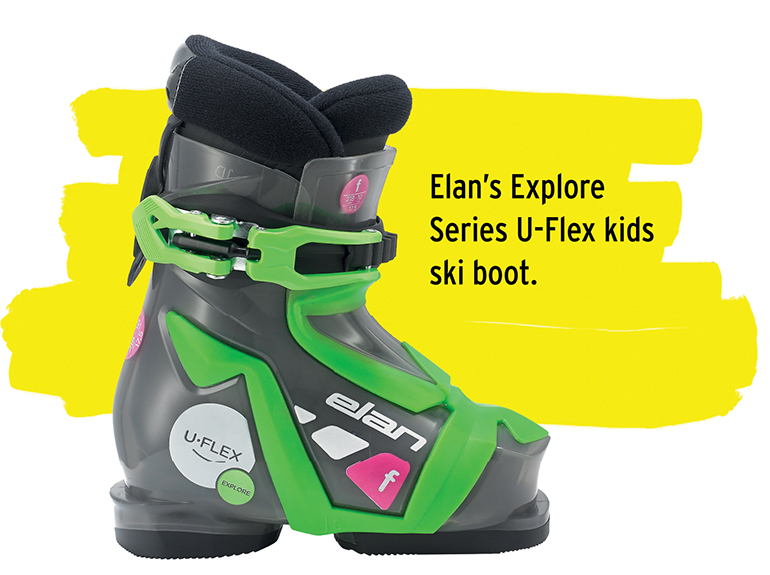
• Rossignol’s 104-mm-last AllTrack Rental boot, for example, can be offered at a fairly modest price, according to Rhim, because increasing rental sales have led to production efficiencies. “A better fitting boot and higher quality materials are enabled by a higher sales volume,” Rhim says, without a price spike.

• Light weight. The AllTrack's light weight also embodies a general trend underway in the rental-boot market. With a 25-percent weight reduction over previous rental models, the AllTrack joins the lighter boot trend along with the new Salomon S Pro 100R and Head’s Nexo Lyt models, as well as Nordica’s new rental line.
CONSOLIDATION CONSIDERATIONS
Rental suppliers are keeping a close eye on the recent consolidation of primarily destination resorts. If either of the biggest multi-resort giants, Vail Resorts and Alterra, were to choose a single rental supplier for all of its resorts, that would likely send reverberations throughout the rental market.
At present, it appears that individual resorts under the corporate umbrellas are making their rental buys autonomously. But if one or both of the corporate giants narrow their supplier list, that could affect the rental market both in terms of price points and the number of suppliers who choose to stay in (or get out of) the rental game. Perhaps that's why manufacturers are introducing relatively few new rental products for 2019-20.
On the other hand, rental products have evolved rapidly in recent years, and a pause allows customers to catch up. And with at least six major players still in the rental business, competition among manufacturers remains healthy for buyers looking for quality equipment at a reasonable price.
So 2019-20 does not appear to be a season that will introduce any major breakthrough products on the rental front or any new or broadly expanded learning-rental programs. Such rental innovations as heated boots and better rental fitting technology, mentioned by a couple of manufacturers’ reps, are sailing on the horizon but are still at least a year or more out. In the meantime, suppliers are treading carefully.
SNOWBOARD RENTAL 2019-20
Snowboard brands both large and small continue to innovate their products for the rental demographic. Here are some of the products slated for 2019-20, along with insights from those who live squarely in the rental world.
ENTRY-LEVEL BOARDS
For beginners and less experienced riders, snowboards that make turning easy and make catching edges difficult have been a major focus.
• Burton's established LTR boards are “designed specifically to help people learn how to snowboard,” says Shaun Cattanach, global resorts manager for Burton. “Using Flat Top and Easy Bevel, these boards are specifically designed to create a catch-free ride and easy turn initiation.”
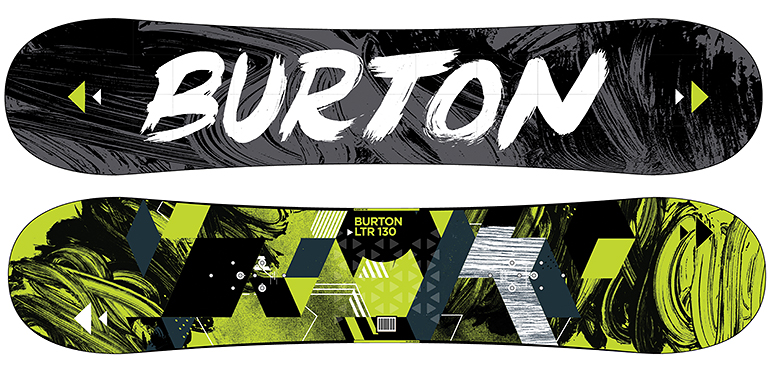
• Never Summer uses a patented rocker/camber hybrid for entry-level rental purposes. “This design winds up being catch-free for new riders in the neutral position, when they are not committed to heel or toe,” says Mike “Gags” Gagliardi, snow sales manager. “The rocker in the center of the board and soft flex is very forgiving, and the camber out by the tip and tail give the rider an opportunity, as they progress, to load up the board and feel the power out of turns.”
• Arbor Snowboards offers a rocker profile. “We offer System Rocker rental boards, a pure rocker profile with griptech contact points placed underneath the toe and heel of the binding, creating the easiest turn initiation and the least likely snowboard to catch an edge,” says Arbor global sales manager John Crouch.
• Rossignol utilizes EXP3 technology, with serrated edges, to reduce chances of catching an edge and also to provide solid edge grip.
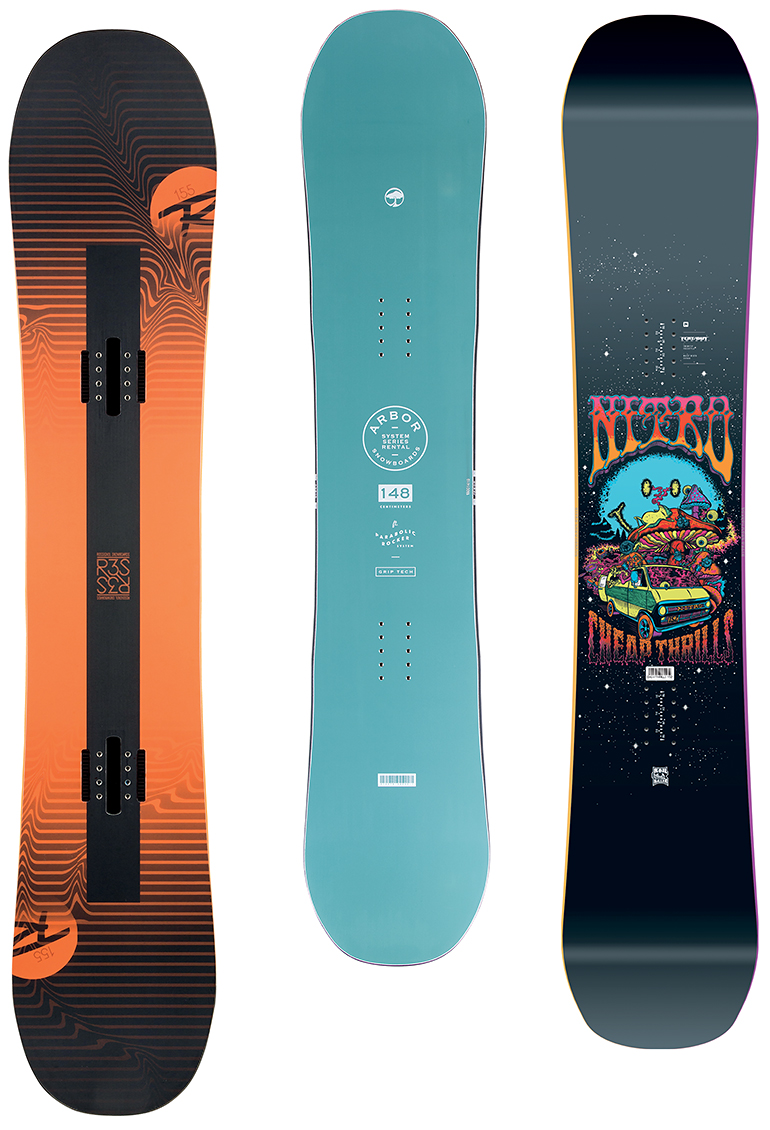 Snowboards left to right: Rossignol EXP 3 Rail 4x4; Arbor’s System Rocker; Nitro Cheap Thrills; Burton LTR.
Snowboards left to right: Rossignol EXP 3 Rail 4x4; Arbor’s System Rocker; Nitro Cheap Thrills; Burton LTR.
BEYOND BEGINNERS
Going beyond specialty beginner rental products, most rental brands continue to offer rental versions of in-line product, reinforced with durable topsheets, tip protectors, and bases, and these models are largely unchanged.
• Nitro Snowboards is adding its freestyle-oriented Cheap Thrills board to the rental selection, with the goal “of getting more beginners and weekend renters to enjoy the park more,” according to Knut Eliassen, Nitro VP of global marketing. Nitro also added a short pow-surfer option to its Quiver Snowboard Rental Collection. It is offered as a unisex board and can help riders make steps to mastering the holy grail of all snowboard pursuits—powder riding. Nitro also offers splitboards for rent or demo to expand access to this specialty gear.
BOOTS, BINDINGS, AND HELMETS
Outside of the board itself—from boots and bindings to helmets and more—brands are looking to find whatever advantage they can to ease the user onto the hill and into the sport.
• Nidecker, which purchased Flow a year ago, is continuing to use Flow binding technology, as it has long been popular in the rental market, and also adds a traditional option. “We offer two solutions: The Nidecker Easy-Lock rental binding, which is a traditional two-strap binding and is easily mounted with the EasyLock disk. The second option is the easy-in easy-out Nidecker Evolve SpeedEntry binding with Flow Technology,” says Lucien Vink, Nidecker senior industrial designer and product manager.
• Nitro is using new materials to increase the durability of its bindings. “We are working with DuPont Zytel and Hytrel materials on our rental bindings for 2019-20, the strongest and most durable technical polymers for use in cold temperature and high impact situations for extra reinforcement,” says Eliassen.
• Head continues with its Speedisk binding technology. Head's rental bindings “are easy to attach and release in the shop, and mechanically provide the tightest link possible between the board and the rider,” says rental product manager Mike Poole.
• Burton is revamping its full boot lineup and adding new patterns for increased comfort and durability. It is using New England Ropes for boot laces and upgrading the Boa reel for enhanced function.
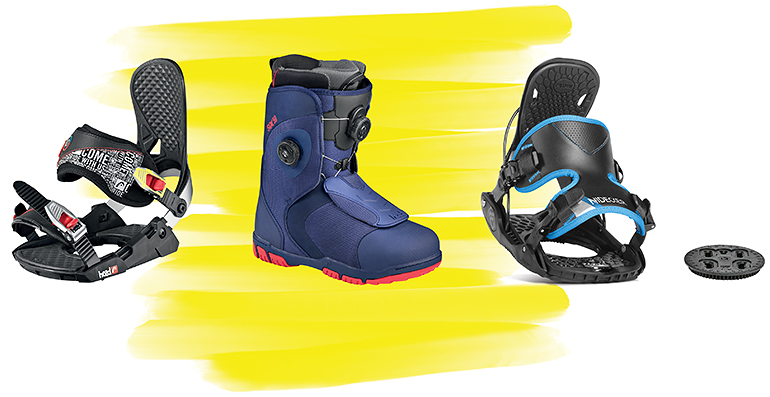 Left to right: Head Speedisk bindings; Head BOA boots; Nidecker Evolve Flow-Technology rental binding.
Left to right: Head Speedisk bindings; Head BOA boots; Nidecker Evolve Flow-Technology rental binding.
As more and more riders are wearing helmets, Burton offers a full rental helmet line for men, women, and children.
THE G-WORD
Growth. The industry depends on it, and rentals can help fuel it. Burton's Cattanach says that overall growth has been slow for the past few years, and expects that to trend to continue. But on the snowboard side there may be reason for optimism, as Millennials are more strongly attracted to snowboarding than other generations. According to a recent survey by Guest Research, roughly 40 percent of Millennials ride, double the percentage for other generations. With Millennials' reluctance to own, could snowboard rentals see more growth?
• Arbor's Crouch says, “We see rentals and higher end demo business growing. We are investing with our retailers to help them be better demo centers."
• Never Summer’s Gagliardi says the company has noticed growth most strongly in its smaller-sized offerings, so having a full range of size options can be beneficial, he says.
• Head has noticed steady, consistent growth in its rental business, says Poole, particularly in fleet and sport rental boards and step-up BOA boots. The pattern for the latter two categories mirrors the trend in alpine rental gear.
• K2 believes that growth is coming from leasing and other options, says Megan Stark, K2 product line manager. “The rental market is on an upswing over the past few years due in part to the popularity of leasing and junior trade programs. Trends throughout all three categories of boards, boots, and bindings have been seeing an uptick that we believe will continue,” she says.
• Burton's Cattanach points to helmets as an example of where he has seen growth, as “more and more resort workers wearing them as part of their on-hill kit" encourages consumers to wear helmets as well.
COOL GRAPHICS
Style matters, perhaps more so for snowboarding than skiing. Snowboarding's audience skews younger, and is more style-conscious. So many brands are paying special attention to aesthetics.
• Nitro's Eliassen says, “We feel that there is no reason for rental boards to look any less cool than regular in-line products. If someone is making the commitment to rent a board, we want them to feel like they fit right in on the mountain from the first day they get there."
• K2's Stark says, “Our rental offering focuses on durability, fit, and aesthetics. We really honed in on making a rental offering that would stand up to the wear and tear on the mountain while keeping a modern aesthetic.”
Overall, the rental market is adapting by building on past experience and offering more choices that suit the needs and desires of end users. “Remember the rental game is where a lot of future or potential snowboarders get their start. We as an industry cannot afford to lose potential snowboarders, young and old, because they got on a cheap and crappy ride,” says Eliassen.





